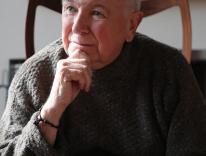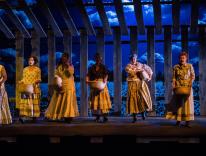January brings the doldrums to the New York theater world. The glitzy Broadway openings of the autumn are over; the spring’s pre-Tony-deadline frenzy has not yet begun. Critics have summed up the previous year in top-ten lists, which have been yawned at and recycled. Tourists go home; locals stay indoors; and producers attempt to bolster their box office with bargain-ticket deals.
This January, though, Off-Broadway’s sophisticated Classic Stage Company (CSC) braved the gloom-and the perennial bah-humbug climate of secular New York-to launch a remarkable production. Directed by CSC’s new artistic director Brian Kulick-who staged Twelfth Night in Central Park with Julia Stiles and Jimmy Smits in 2002-The Mysteries fused medieval mystery play with contemporary revisionist retellings of the Christ story. The show’s first half, relating Old Testament stories like Noah and the flood and Cain and Abel, drew from the York and Wakefield mystery cycles-biblical plays staged by medieval English craft guilds. The second half of Kulick’s production showcased part of the Pontius Pilate section from Soviet writer Mikhail Bulgakov’s masterpiece The Master and Margarita, besides a dramatized scene from the novel Time of Miracles by Serbian dissident Borislav Pekic, and two scenes from the play Mistero Buffo by the Nobel Prize-winning playwright Dario Fo, whose works have scandalized the Vatican.
This pairing of old and new was doubly provocative. On the one hand, the medieval plays affirm, and celebrate, traditional Christian teachings, whereas the Bulgakov, Pekic, and Fo selections opt for a more skeptical view: Bulgakov’s Jesus complains that Matthew’s Gospel is full of lies; Pekic imagines a repeatedly resurrected Lazarus trying to escape from both Jesus and the Sadducees; Fo depicts the Lazarus miracle degenerating into an entertainment circus, complete with gawking spectators and concessionaires. A traditionalist might easily jump to the (unwarranted) conclusion that the show’s second half is irreligious.
On the other hand, America’s theatrical establishment takes Christianity seriously about as often as Taiwan gets chummy with mainland China, so CSC and Los Angeles’s Actors’ Gang Theatre, the ultra-hip theater that premiered Kulick’s script last fall, took substantial risks in staging the piece to begin with. Sure enough, some New York reviewers proved ridiculously close-minded: “The only mystery is how it came to be staged in the first place,” the New York Times reviewer sniffed, while the critic for the Web site Broadway.com carped that the production failed to show why the medieval texts “matter to today’s audiences”-this for scenes, mind you, that deal with such matters as free will and the origins of evil.
In fact, The Mysteries turned out to be a spare, eloquent, and unusually moving production, inflected with comic moments and full of beautiful or unnerving images-a bushel of red apples tossed on the floor, in the Garden of Eden scene; a blithe Pontius Pilate donning a snazzy suit after Jesus has cured his headache. With its evocation of an artisan’s workshop, the basic set-wooden tables arranged on a sawdust-strewn floor-seemed to defuse any simplistic interpretation of the Bulgakov-Fo-Pekic excerpts. Far from being blasphemous, these revisionist gospels felt like meditations aimed at facilitating an encounter-and a struggle-with the concept of the divine; they were stages in the work-in-progress that is belief.
Given the frosty attitude toward Christianity in many theatrical circles, how could a risky proposition like The Mysteries come to be? In an interview half-way through the New York run, Kulick explained that the catalyst had been the birth four years ago of his son. Though he himself is “congenitally agnostic,” he says, he realized that he and his wife-both raised Jewish-would eventually have to decide what to tell their child about God. “I started trying to read every thing I could get my hands on,” the director recalls. “And none of it was making human sense”-and then he stumbled upon the mystery plays, which he’d once read cursorily as an undergraduate. At this point in his life, the medieval scripts dazzled him with their emotional dynamism. “They were able to make these dilemmas-these abstract notions-human, bring them out of the clouds and down to the earth,” he says. But just rereading the pieces wouldn’t do it for him, he realized-he’d have to stage them. “The best way I know for me to understand things is go into a room with a text with a group of actors,” he explains. “And four weeks later, in three dimensions, I can start to understand something.”
At this point movie star Tim Robbins entered the picture. The artistic director of L.A.’s Actors’ Gang, Robbins invited Kulick, an old friend, to stage something for the company. Kulick proposed the mystery plays.
“There was this long pause,” the director recalls. “He said, ‘The religious ones?’ ‘Yeah, those!’ Long pause.” Nevertheless, Robbins agreed-“more out of friendship than producerial acumen,” Kulick thinks-but suggested that the show’s second half sample modern texts.
Excited by this idea, Kulick chose three twentieth-century writers who had worked in theater (both Bulgakov and Pekic wrote plays as well as novels), and he welded together a script whose components, in his view, share a “secret DNA”-namely, “a conversation between one who believes and one who doesn’t, one who’s open to the miraculousness of being and one who’s closed.” The conversations work theatrically, he adds, because they lure the audience into empathy. He cites the confrontation between Abel and Cain, who skimps on his sacrifice and insults God, to boot (“Who is that hob-over-the-wall?” Cain jokes after the Divine Being makes a brief appearance in this excerpt from the Wakefield mystery cycle). The scene culminating in Abel’s murder, Kulick says, “takes you microstep by microstep through the human minefield of emotion that lead to that tragic act. But even more interestingly, it allows you to get excited by and titillated by Cain, so you become complicit with Cain up to the moment where he kills. It’s that understanding of drawing the audience in, having them for a moment root for the bad guys, ostensibly, that’s the genius of these plays. They always find a way to hook you. With Cain and Able, you get a sense there’s almost a political statement with Cain: he’s almost like a proto-Lenny Bruce; he’s saying the things that shouldn’t be said but we all think.”
So if these religious playlets are essentially such crowd pleasers, why aren’t they staged more often? Why have critics raised their eyebrows at CSC’s The Mysteries? Pointing to the uproar over Mel Gibson’s movie about Christ’s passion [see editorial page 5, and John A. Coleman, page 12], Kulick hypothesizes that people nowadays are “very freaked out about religion and representations of religion.” And he suggests that, in general, “we’re in a spiritually impoverished place as a culture”-a condition that, paradoxically, makes us want to run still further from spirituality-“put it in a box, leave it alone, as opposed to really being in dialogue with it.”
If it’s tough to start that dialogue on an L.A. or New York stage, Kulick feels, it’s worth it. “I’m a big believer in what the nineteenth-century Russians used to call the ‘accursed questions,’” he says. “‘Why are we here?’ ‘How should we live?’ Art is about not answering them but spending a period of time with them, in the hope that we’ll walk out reoriented.”
Please email comments to [email protected] and join the conversation on our Facebook page.
Previous Story
Mel Gibson Meets Marc Chagall
Next Story
Rolling Along

